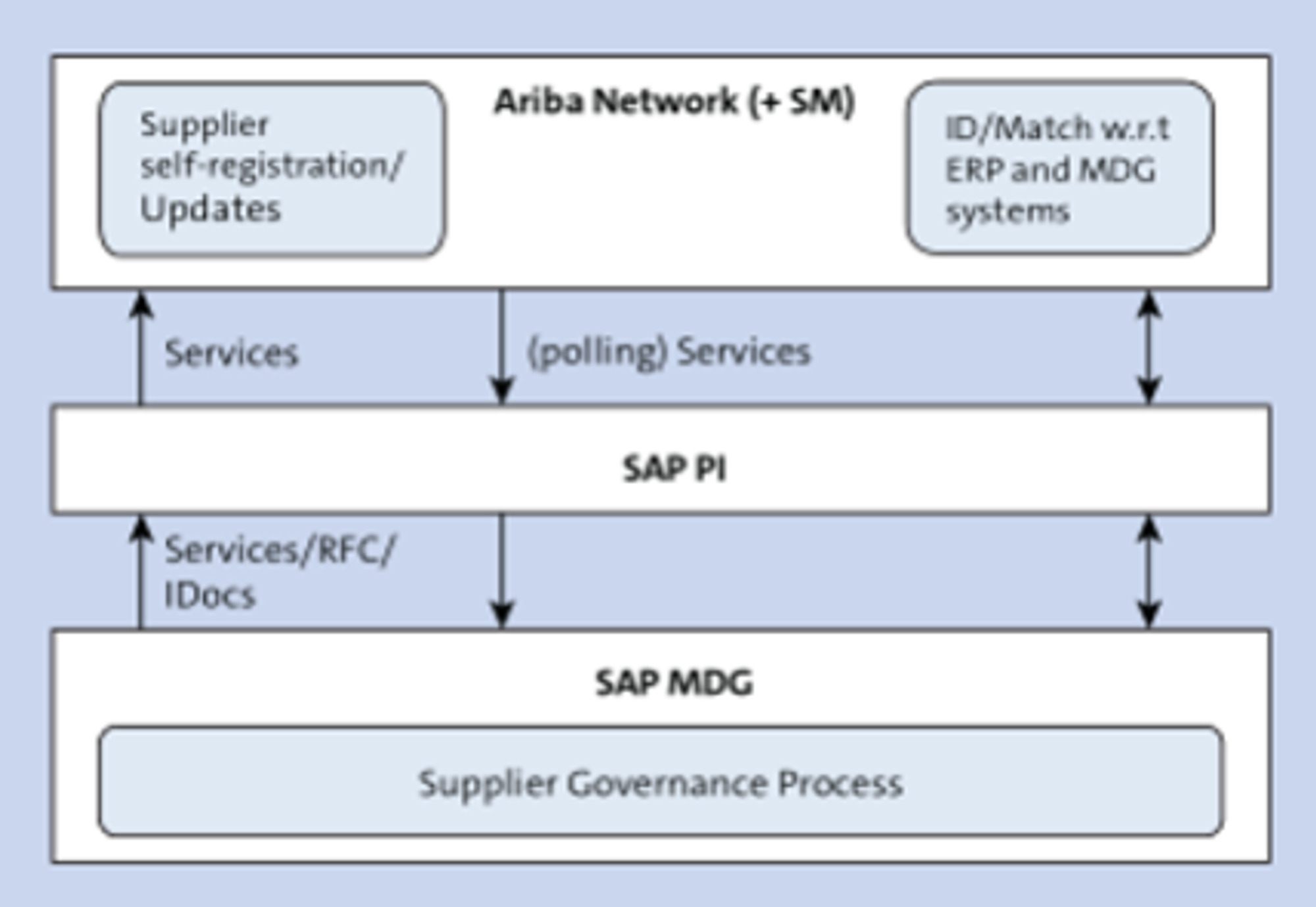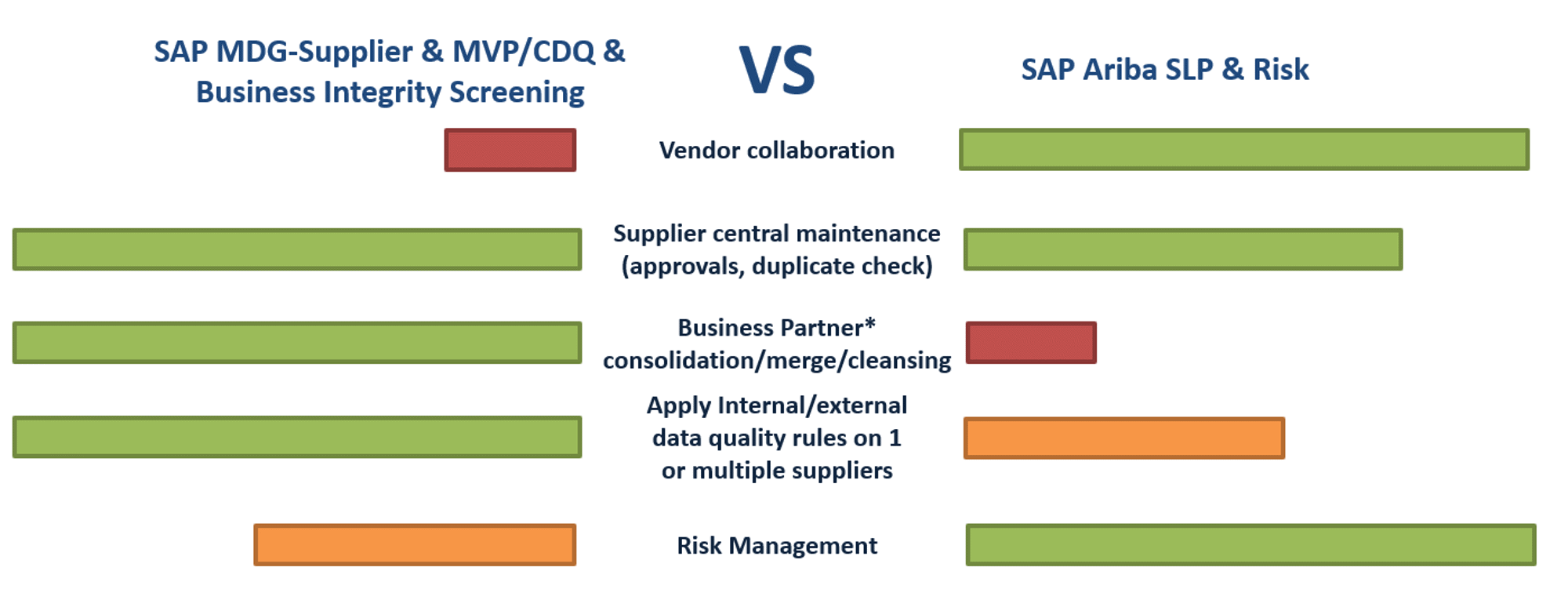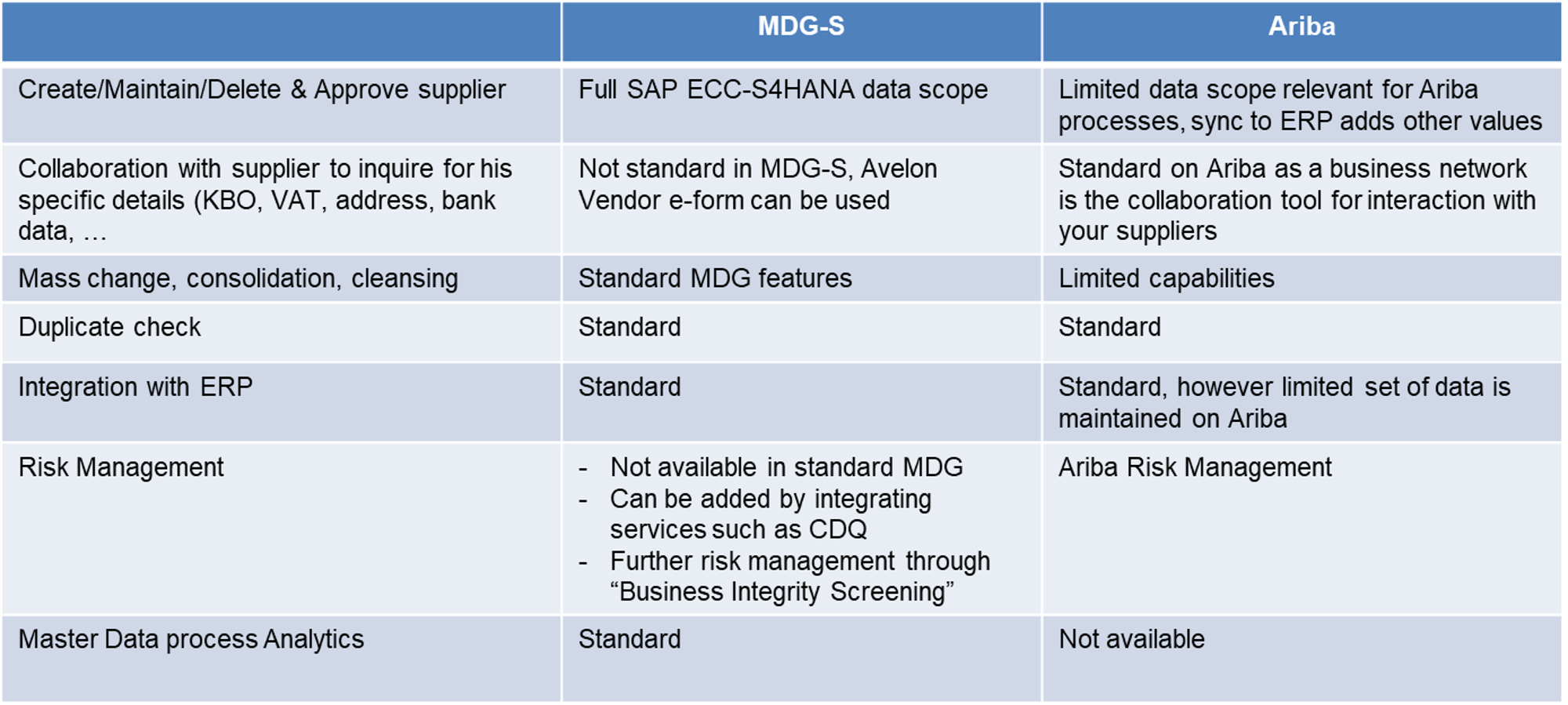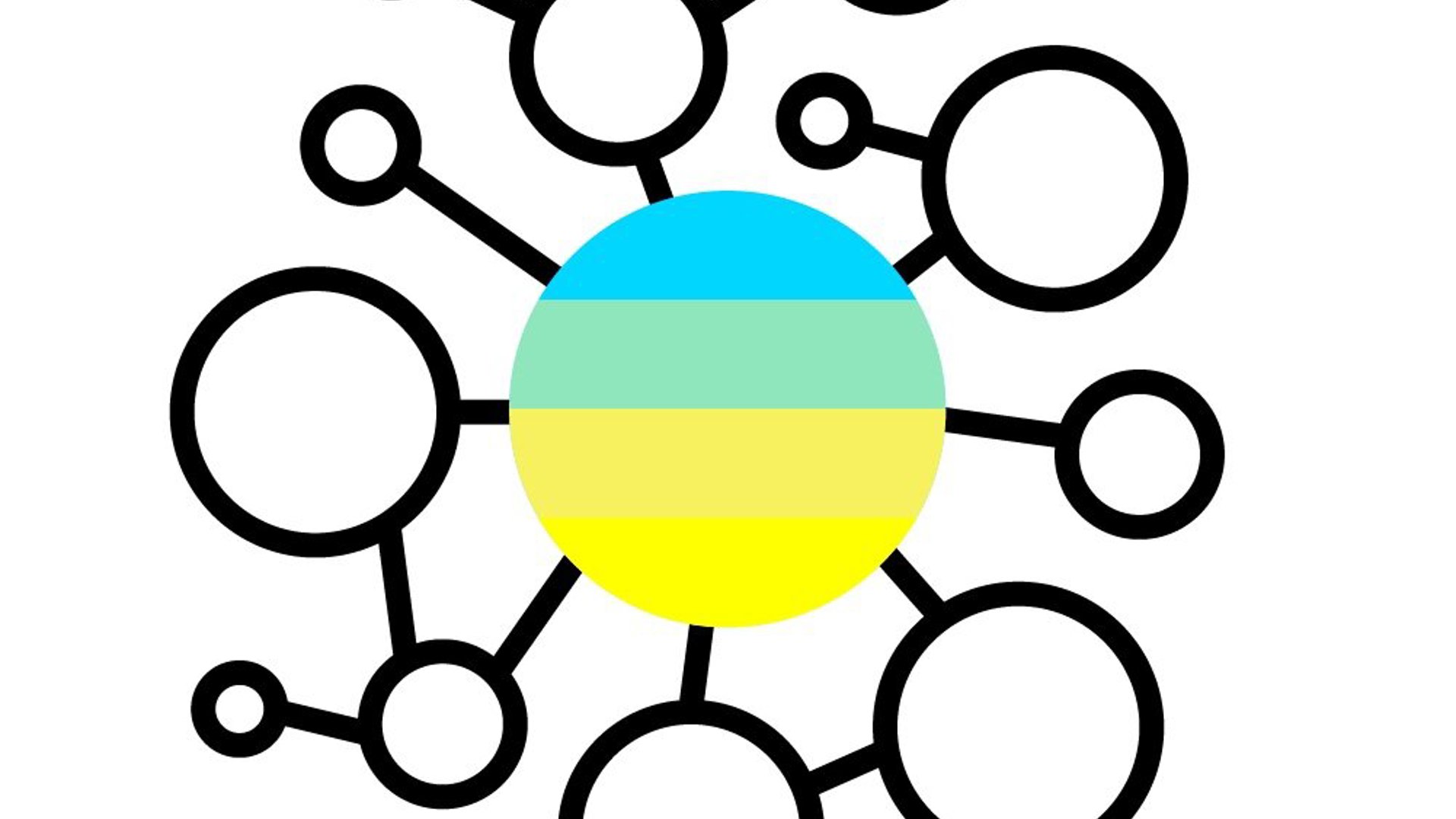In short, SAP Ariba Supplier Management is a cloud-based suite that provides a set of linked tools to manage suppliers. You can add new suppliers to your database using internal and external requests. Suppliers can also register themselves to collect and manage detailed profile information.
SAP MDG-S is an out-of-the-box solution to centrally govern, maintain and distribute your supplier master data. Creation and modification of suppliers can be done through change requests that are approved based on an approval workflow running behind. In addition, multiple cleansing scenarios are foreseen to make or keep your data clean (SAP MDG Mass Processing and Consolidation).
Risk Management
Risk management helps to protect companies from making bad decisions about the choice of their suppliers. Working with a suspicious supplier or with suspicious data could damage both revenue and reputation. For many businesses, it is legally required to check their business partners. To manage this, screening lists, provided and updated by governments and institutions across the world, can be used.
The risk management products described in this blog make use of the “alert” principle: when the detection mechanism finds a problem or something suspicious, an alert is created. This alert serves as a trigger for the data specialist who then needs to take action. It is also possible to trigger alerts manually, based on business rules.
High-level comparison
Ariba

SAP Ariba has a built-in risk management mechanism. This functionality uses data from multiple service providers, public and private, including articles, news reports, company information, and other third-party content, and makes that information readily available. Supplier risk exposure and alerts can be monitored on the Ariba Supplier Risk Dashboard. It is also possible to receive e-mail notifications when alerts are generated.
For the calculation of the risk exposure, data sources can be specified. There are two categories of data sources: default sources and licensed sources.
The following sources are enabled by default:
- Global disasters
- Geographical data on natural disasters that can affect suppliers.
- Country risk
- Risk data associated with the supplier's country.
- Incidents
- News items about suppliers.
- Corporate information
- Corporate information such as years in business, years in business under the same owner, number of liens or bankruptcy filings, and so on.
In addition to that, licensed sources become available once a license has been signed with the source institution.
Regarding alerts, users can:
- View alert details and open links to news sources.
- Share alerts via email.
- Filter, flag, sort, and archive alerts.
- Subscribe to alerts for specific types of incidents from specific suppliers.
- Enable and disable email notifications for alerts.
- Configure severity levels for alerts of specific incident types.
- Provide feedback about alerts to be reviewed for improvements.
MDG
SAP Business Partner Screening let you screen your business partners against the screening lists mentioned above. This tool can be integrated in the MDG customizing and following two integration scenarios: synchronous and asynchronous.

The other integration mode lets you trigger an address screening process asynchronously from the MDG change request workflow. If hits are found, the corresponding alerts will be created. A compliance expert will then check these alerts and decide whether the change request can continue or return the change request with the alert information to the data specialist. This is called the “Manual Decision” option. An “Automatic Cancellation” option exists also. In this case, there is no manual intervention required from a data specialist. When hits are confirmed based on address screenings, depending on the configuration, the workflow can be automatically cancelled or other actions can be executed in relation to the change request.
There is a ‘Manage Alerts’ Fiori application that lets you:
- Display a list of all the alerts in the system.
- Access the alert details.
- Link directly other colleagues to the alert via your phone or email application.
- Create alerts manually.
- Assign all or any number of alerts and alert items to yourself or to another investigator or reset the assignment by selecting the corresponding checkbox.
- Complete the alerts.
- Export the list of alerts to a spreadsheet.
- Save your filter and table settings as a Fiori tile on your home screen.
SAP Ariba and MDG-S together
SAP Ariba and MDG-S can work well together. You have the possibility to determine which one of the two is the leading system. When a supplier is created on one system, it is important to execute a duplicate check on the other system. Whenever updates are found on Ariba, the relevant data will be sent to the MDG system, using Process Integration (PI), and it will be governed through an SAP MDG Change Request Process. After that, it can be replicated in other systems.

What are the biggest differences?
Both tools support the creation and management of suppliers with the help of an approval workflow that is customizable. For Ariba, this can be done from the Ariba Dashboard. For MDG-S this can be done using the Netweaver Business Client or the Fiori Launchpad.
As the comparison matrix shows, most of the features are supported by both tools. The difference is in up to what extent each feature is supported. Overall, Ariba focuses more on supplier collaboration and risk management. On the other hand, MDG puts more emphasis on data quality.

MDG doesn’t have a standard collaboration network as in Ariba, but Alluvion proposes a Vendor e-form to request and integrate additional data from the supplier. The Vendor e-form works as follows: once the supplier has been created in MDG, the system sends an e-form to the supplier. The supplier fills in his data and submits the e-form, the system validates the data and sends the data to MDG. See also Alluvion MDG Productivity Pack
When it comes to Risk management, there is no standard tool in MDG, but multiple services are available and can be integrated. Some of these services include Business Partner Screening, Business Integrity Screening, CDQ (Corporate Data Quality), D&B…
Another comparison angle is the date scope: MDG covers the whole ECC-S/4HANA scope while Ariba is more focused on Ariba-related processes. The implication is that if you create a supplier with Ariba, it will be correctly synchronized with ECC-S/4HANA, but only for the Ariba-related values. Other attributes will be filled in with default values and that could cause difficulties afterwards when the supplier will be used in other processes.

Conclusion
The focus of Ariba is more on risk management and less on data quality and governance. The collaboration with suppliers is a key differentiator for Ariba. On the other hand, MDG is built with data quality and governance in mind. As illustrated, SAP MDG can interact with Ariba to benefit from more thorough risk management functionalities. MDG can also work with complementary tools from SAP such as Business Partner Screening or even Business Integrity Screening in order to meet the capacities of SAP Ariba. Therefore, it is not an “either-or” situation since both tools have broadly similar functionalities. But if you are SAP Based, you can confidently use SAP MDG to manage your suppliers and avoid putting your company at risk by trusting the wrong business partners.
For further questions or information about this subject, do not hesitate to get in touch!
For more information on this subjects, feel free to fill in the form below.
One of our experts will get in touch soon.

Wouter Van Peteghem
Managing Partner
With 23 years of experience in SAP, Wouter is now responsible for business development, HR and daily operations at Alluvion.
Featured articles






